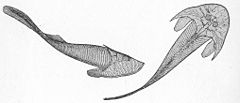- Cephalaspidomorphi
-
Cephalaspidomorphs 
Reconstruction of Cephalaspis lyellii Scientific classification Kingdom: Animalia Phylum: Chordata (unranked): Craniata (unranked): Cephalaspidomorphi Subgroups Osteostraci
Galeaspida
Pituriaspida
Anaspida
Hyperoartia - lampreys (disputed)Cephalaspidomorphs are a group of jawless fishes named for the cephalaspids, a group of osteostracans. Most biologists regard this taxon as extinct, but the name is sometimes used in the classification of lampreys because lampreys were once thought to be related to cephalaspids. If lampreys are included, they would extend the known range of the group from the Silurian and Devonian periods to the present day.
Contents
Classification
In the 1920s, the biologists Johan Kiær and Stensiö first recognized the Cephalaspidomorphi as including the osteostracans, anaspids, and lampreys, because all three groups share a single dorsal "nostril", now known as a nasohypophysial opening.
Since then, opinions on the relations among jawless vertebrates have varied. Most workers have come to regard the agnatha as paraphyletic, having given rise to the jawed fishes. Because of shared features such as paired fins, the origins of the jawed vertebrates may lie close to the Cephalaspidomorphi. Many biolgists no longer use the name Cephalaspidomorphi because relations among Osteostraci and Anaspida are unclear, and the affinities of the lampreys are also contested. Others have restricted the cephalaspidomorphs to include only groups more clearly related to the Osteostraci, such as Galeaspida and Pituriaspida, that were largely unknown in the 1920s.[1]
Lampreys
Some reference works and databases have regarded Cephalaspidomorphi as a Linnean class whose sole living representatives are the lampreys.[2] Evidence now suggests that lampreys acquired the characters they share with cephalaspids by convergent evolution.[3] [4] As such, many newer works about fishes classify lampreys in a separate group called Petromyzontida or Hyperoartia.[5]
External links
References
- ^ White, Toby. "Thelodonti: Cephalaspidomorphi". Palaeos. http://www.palaeos.com/Vertebrates/Units/050Thelodonti/050.400.html#Cephalaspidomorphi. Retrieved 2009-10-27.
- ^ Nelson, Joseph S. (1994). Fishes of the World (Third ed.). John Wiley and Sons. ISBN 0-471-54713-1.
- ^ Forey, Peter, & Janvier, Philippe (2000). "Agnathans and the origin of jawed vertebrates". In Gee, Henry. Shaking the tree: readings from Nature in the history of life. USA: University of Chicago Press; Nature/Macmillan Magazines. pp. 251–266. ISBN 9780226284972
- ^ Janvier, Philippe (2008). "Early Jawless Vertebrates and Cyclostome Origins". Zoological Science 25 (10): 1045–1056. doi:10.2108/zsj.25.1045. PMID 19267641.
- ^ Nelson, J. S. (2006). Fishes of the World (4th ed.). New York: John Wiley and Sons, Inc. pp. 601 pp.. ISBN 0-471-25031-7.
Janvier, Philippe. Early Vertebrates Oxford, New York: Oxford University Press, 1998. ISBN 0-19-854047-7
Stensiö, E. A. (1927). The Devonian and Downtonian vertebrates of Spitsbergen. 1. Family Cephalaspidae. Skrifter om Svalbard og Ishavet, 12, 1-391.
Categories:- Vertebrates without jaws
Wikimedia Foundation. 2010.
